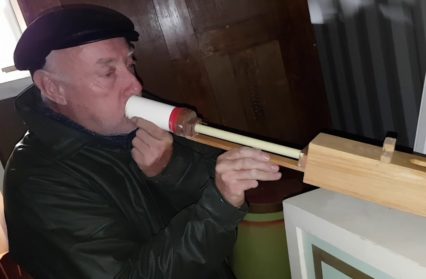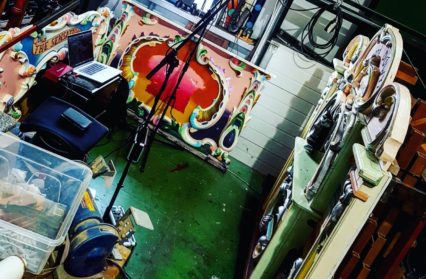David Roche tells us about the process of preparing ten new commissions (including the one that he has written) for Astrid the Dutch street organ as part of the 2019 Vale of Glamorgan Festival.

From faithful realisations of Xenakis’ feverishly difficult piano music to complete MIDI realisations of the movie Shrek, I think it’s safe to say that computers play a very important role in the lives of working musicians – especially composers. Improvements in technology drive a lot of new music and, in preparation for the 2019 Vale of Glamorgan Festival, I have been getting to grips with a series of technologically modified street organs owned and maintained by Francis Stapleton. You can check out my little video introduction below:
Francis Stapleton runs an organ museum just outside Bala. He has a huge number of smaller – but, I think, still massive – street organs and dance organs. Each of these organs is a great big industrial musical instrument constantly pumping air around. This air is channelled towards tuned pipes and valves that control the sound. These organs produce music by being fed a cardboard book with holes cut into it. These holes allow air through, when the air passes and touches certain components inside a given organ it activates a mechanism that produces a sound. Although a lot of organs can still perform using this method, digital systems are now often used to make things a little more streamlined.
Francis’ collection of organs really reminds me of older player pianos. If you’ve never heard one of these before, they’re often those pianos you see in Westerns with a spinning roll in the centre of the piano and no visible performer (How It’s Made even created a documentary). Although the card that passes through these machines is a fixed and rigid musical score, these instruments still have a huge performative aspect. Amazing musicians like Sergei Rachmaninov and Percy Grainger recorded their music for player pianos, musicians like Rex Lawson work on player pianos controlling the speed and interpretation of the music that the instrument is being fed, and composers like Conlon Nancarrow used player pianos to create new music (although, admittedly, he wrote it out by hand first). Some of Nancarrow’s wild music was eventually transcribed for traditional performance and became important in the progression of modern classical music… It’s also just fantastic, so listen to it!
The coolest thing about Francis’ collection of organs, for me, is the contrast between the more traditional elements (carved pipes, bellows, valves) and the more modern components (MIDI controllers, magnetic vales, laptops). The newer additions feel like bionic improvements on something much older and more mysterious. You can learn a bit more about all of these improvements by having a look at another of my videos:

Ten composers have been commissioned to write for one of Francis’ most heavily-modified instruments, Astrid. She started life with far fewer pipes, and no MIDI controllers attached. Over the years many different ranks of pipes, controllers, and valves have been added. Customisation is a huge part of the culture relating to these organs. The preservation and improvement of these instruments are purely down to the dedication and commitment of their owners – people like Francis. Because of all of these additions, it’s quite incredible to hear the music Astrid can make. There’s just so, so much one can do with this instrument.
I’m fortunate and privileged to be one of the commissioned composers tasked with writing for Astrid. In my piece, I am exploring everything that I can’t do with regular acoustic instruments; impossibly complicated rhythms, huge and fast leaps, massively dense chords, and total – absolute – metronomic accuracy. My piece is strongly inspired by a genre of music called black MIDI. A type of music where a MIDI sequencer piano roll (a sequencer is a program used to create music for MIDI instruments) is absolutely covered in notes from end to end. It’s extremely liberating to be able to compose wildly inhuman music and I’m taking absolutely no care to ensure that I rein it in. My new composition is all about losing control, disintegration, and destruction. Rather like this extremely unusual video of a washing machine ripping itself apart to Nancarrow’s music…
Astrid will be performing all 10 of these pieces in Wales over the next few months with the premieres taking place as part of the 2019 Vale of Glamorgan Festival. The music is going to be fantastic; it’s going to sound great and it’s going to be something totally new and different. Support new music in Wales and come along on the 18th and 19th of May.
To be informed when future Vale of Glamorgan Festival events is organised, click here.
David Roche is a regular contributor to Wales Arts Review.












